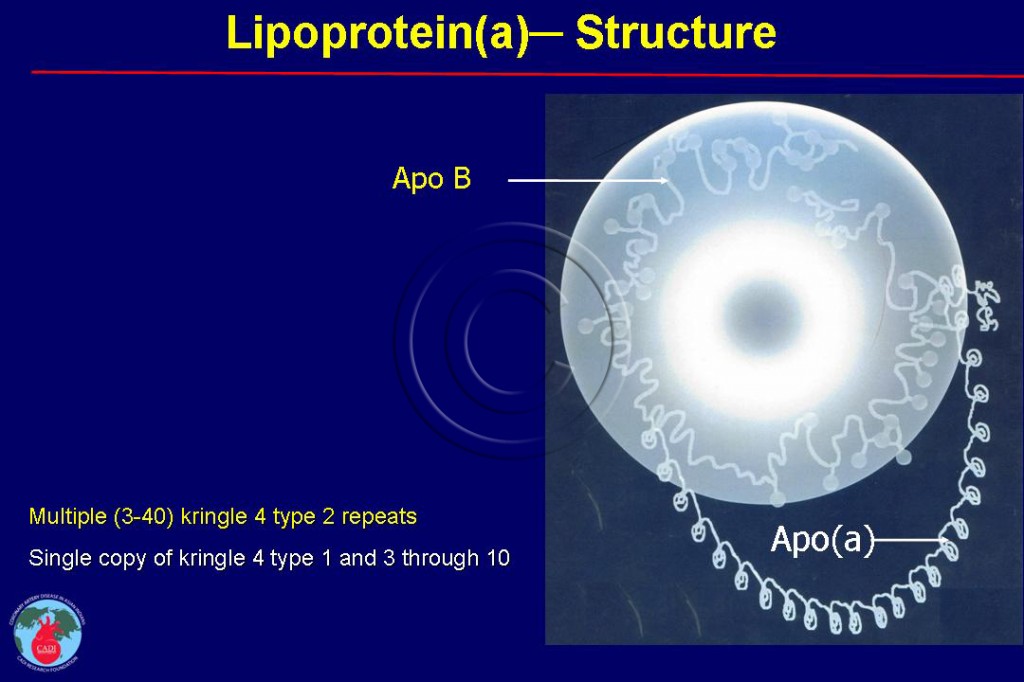Lipoprotein (a) Isoforms
- Lipoprotein(a) (Lp(a)) is a genetic variant of the LDL cholesterol, with an additional apo protein called apolipoprotein(a) (apo(a)).1
- Apolipoprotein(a) carries a region called KIV type 2 repeat sequence or kringle repeat that varies from 2 to >40.1 The number of repeats of the kringle sequence is genetically determined and variable. This enigmatic lipoprotein has more than 34 different isoforms depending upon the number of kringle repeats (k 4 type2) domains (Figure 058).2
- The smaller isoforms (<22 k4 repeats) have strong association with premature vascular disease (2-fold risk) whereas the larger isoforms have minimal or no risk for CAD (coronary artery disease) regardless of the presence of other risk factors such as high blood pressure, diabetes, or high cholesterol.2-4
- Asian Indians are an exception among whom both small and large isoforms are associated with premature CAD.5-8
- Elevated Lp(a) levels with small apo(a) isoforms are significantly associated with CAD in blacks and whites.9 However, smaller isoforms predominate in whites and larger isoforms in blacks. This explains why the relationship between Lp(a) levels and CVD (cardiovascular disease) risk has been weak in blacks in many studies.2
- The isoform size is inversely related to Lp(a) levels. The risk is synergistically increased when both high Lp(a) levels and small isoforms are present.2 The analysis of apo(a) polymorphism appears to be particularly useful in healthy subjects with a family history of atherothrombotic diseases, as well as in patients with diseases at high cardiovascular risk (diabetes, high blood pressure, high cholesterol).10
- Small apo(a) isoforms may be considered as a genetic marker of severity of coronary atherosclerosis, thrombosis, as well as very early development of heart attack.2, 11, 12
- The marked variation in the size of Lp(a) isoform presents a unique challenge in the determination of Lp(a) concentrations. Many commercial laboratory measurements underestimate Lp(a) levels in individuals with small isoforms and overestimate the levels in those with larger isoforms.13, 14 This is because of the use of antibodies that recognize KIV type 2 epitopes that have multiple copies. Many of the studies with negative results used these assay methods, thereby underestimating or obscuring the true relationship of Lp(a) concentration and vascular disease.14-17 ( see Lp(a) measurements)
Sources
1. Nordestgaard BG, Chapman MJ, Ray K, et al. Lipoprotein(a) as a cardiovascular risk factor: current status. Eur Heart J. Oct 21 2010.
2. Enas EA, Chacko V, Senthilkumar A, Puthumana N, Mohan V. Elevated lipoprotein(a)–a genetic risk factor for premature vascular disease in people with and without standard risk factors: a review. Dis Mon. Jan 2006;52(1):5-50.
3. Erqou S., Thompson A, Di Angelantonio E, et al. Apolipoprotein(a) isoforms and the risk of vascular disease: systematic review of 40 studies involving 58,000 participants. J Am Coll Cardiol. May 11 2010;55(19):2160-2167.
4. Kronenberg F, Kronenberg MF, Kiechl S, et al. Role of lipoprotein(a) and apolipoprotein(a) phenotype in atherogenesis: prospective results from the Bruneck study. Circulation. 1999;100(11):1154-1160.
5. Xiong ZW, Wahlqvist ML, Ibiebele TI, et al. Relationship between plasma lipoprotein (a), apolipoprotein (a) phenotypes, and other coronary heart disease risk factors in a Melbourne South Asian population. Clin Biochem. Apr 2004;37(4):305-311.
6. Geethanjali FS, Jose VJ, Kanagasabapathy AS. Lipoprotein (a) phenotypes in south Indian patients with coronary artery disease. Indian Heart J. 2002;54(1):50-53.
7. Geethanjali FS, Luthra K, Lingenhel A, et al. Analysis of the apo(a) size polymorphism in Asian Indian populations: association with Lp(a) concentration and coronary heart disease. Atherosclerosis. Jul 2003;169(1):121-130.
8. Gambhir JK, Gambhir D, Morreset J. Lipoprotein(a) in normal indian subjects and and patints with coronary artery disease. Indian Heart J. 1998;50:563.
9. Paultre F, Pearson TA, Weil HF, et al. High levels of Lp(a) with a small apo(a) isoform are associated with coronary artery disease in African American and white men. Arterioscler Thromb Vasc Biol. 2000;20(12):2619-2624.
10. Gazzaruso C, Garzaniti A, Geroldi D, Finardi G. Genetics and cardiovascular risk: a role for apolipoprotein(a) polymorphism. Cardiologia. 1999;44(4):347-354.
11. Gazzaruso C, Geroldi D, Garzaniti A, et al. Apolipoprotein(a) phenotypes as genetic markers of coronary atherosclerosis severity. Int J Cardiol. 1998;64(3):277-284.
12. Merki E, Graham M, Taleb A, et al. Antisense Oligonucleotide Lowers Plasma Levels of Apolipoprotein (a) and Lipoprotein (a) in Transgenic Mice. J Am Coll Cardiol. Apr 12 2011;57(15):1611-1621.
13. Marcovina SM, Albers JJ, Gabel B, Koschinsky ML, Gaur VP. Effect of the number of apolipoprotein(a) kringle 4 domains on immunochemical measurements of lipoprotein(a). Clin Chem. 1995;41(2):246-255.
14. Marcovina SM, Koschinsky ML, Albers JJ, Skarlatos S. Report of the National Heart, Lung, and Blood Institute Workshop on Lipoprotein(a) and Cardiovascular Disease: recent advances and future directions. Clin Chem. Nov 2003;49(11):1785-1796.
15. Ridker PM, Stampfer MJ, Hennekens CH. Plasma concentration of lipoprotein(a) and the risk of future stroke. Jama. 1995;273(16):1269-1273.
16. Ridker PM, Hennekens CH, Stampfer MJ. A prospective study of lipoprotein(a) and the risk of myocardial infarction. Jama. 1993;270(18):2195-2199.
17. Ridker PM, Stampfer MJ, Rifai N. Novel risk factors for systemic atherosclerosis: a comparison of C-reactive protein, fibrinogen, homocysteine, lipoprotein(a), and standard cholesterol screening as predictors of peripheral arterial disease. Jama. May 16 2001;285(19):2481-2485.


